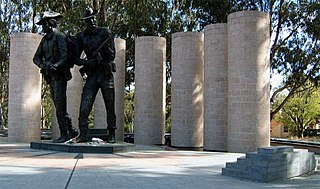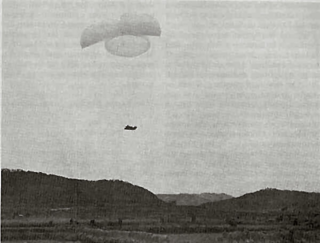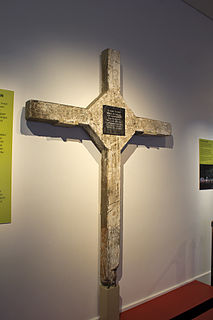
The Battle of Kapyong, also known as the Battle of Jiaping, was fought during the Korean War between United Nations Command (UN) forces—primarily Canadian, Australian, and New Zealand—and the Chinese People's Volunteer Army (PVA). The fighting occurred during the Chinese Spring Offensive and saw the 27th British Commonwealth Brigade establish blocking positions in the Kapyong Valley, on a key route south to the capital, Seoul. The two forward battalions—the 3rd Battalion, Royal Australian Regiment and 2nd Battalion, Princess Patricia's Canadian Light Infantry —were supported by guns from the 16th Field Regiment of the Royal Regiment of New Zealand Artillery along with a company of US mortars and fifteen Sherman tanks. These forces occupied positions astride the valley and hastily developed defences. As thousands of soldiers from the Republic of Korea Army (ROK) began to withdraw through the valley, the PVA infiltrated the brigade position under the cover of darkness, and assaulted the Australians on Hill 504 during the evening and into the following day.

The Mackenzie–Papineau Battalion or Mac-Paps were a battalion of Canadians who fought as part of the XV International Brigade on the Republican side in the Spanish Civil War in the late 1930s. Except for France, no other country had a greater proportion of its population volunteer in Spain as did Canada. The XV International Brigade, made up also of volunteer battalions from the United States and Britain, was involved in the Battle of Jarama, in which nine Canadians are known to have been killed.

The Royal Australian Regiment (RAR) is the parent administrative regiment for regular infantry battalions of the Australian Army and is the senior infantry regiment of the Royal Australian Infantry Corps. It was originally formed in 1948 as a three battalion regiment; however, since then its size has fluctuated as battalions have been raised, amalgamated or disbanded in accordance with the Australian government's strategic requirements. Currently, the regiment consists of seven battalions and has fulfilled various roles including those of light, parachute, motorised and mechanised infantry. Throughout its existence, units of the Royal Australian Regiment have deployed on operations in Japan, Korea, Malaya, Borneo, Vietnam, Somalia, Rwanda, Cambodia, East Timor, the Solomon Islands, Iraq and Afghanistan.

The Royal Australian Air Force Memorial is on Anzac Parade, the principal ceremonial and memorial avenue of Canberra, the capital city of Australia.

The Australian Army Memorial on Anzac Parade commemorates the service of Australian soldiers.

The Hellenic (Greek) Memorial is on Anzac Parade, beside the Australian War Memorial in Canberra, the national capital city of Australia.

The New Zealand Memorial in Canberra, Australia, commemorates the relationship between New Zealand and Australia, and stands at the corner of Anzac Parade and Constitution Avenue, the former bisecting the Parliamentary Triangle and the latter forming the base of the triangle that represents the form of government in Canberra, the national capital city of Australia.

The 3rd Battalion, The Royal Australian Regiment is a mechanised infantry battalion of the Australian Army, based in Kapyong Lines, Townsville as part of the 3rd Brigade. 3 RAR traces its lineage to 1945 and has seen operational service in Japan, Korea, Malaya, Borneo, South Vietnam, Rifle Company Butterworth, East Timor, the Solomon Islands, Afghanistan and Iraq.

The ACT Memorial is an Australian war memorial honouring men and women associated with the Australian Capital Territory who served in a number of conflicts and peacekeeping missions throughout the world. Located in Canberra, on London Circuit, opposite Civic Square, the ACT Memorial consists of two primary components: a physical memorial, and a web site providing public access to a database of names and information about those honoured by the memorial. The memorial was dedicated on 10 August 2006 by the ACT Chief Minister, Mr Jon Stanhope MLA.

Australia's National Police Memorial is in the national capital, Canberra, in King's Park on the northern shore of Lake Burley Griffin adjacent to the National Carillon on Aspen Island. It commemorates Australian police who have died on duty.

Australia entered the Korean War on 28 September 1950, following the invasion of South Korea by North Korea. The war's origins began in the context of Japan's defeat in World War II which heralded the end to 35 years of Japanese occupation of the Korean Peninsula. The surrender of Japan to the Allied forces on 2 September 1945 led to the division of Korea into two countries, which were officially called the Democratic People's Republic of Korea (DPRK) and the Republic of Korea (ROK), with the DPRK was occupied by the Soviet Union, and the ROK, below the 38th Parallel, was occupied by the United States (US).
Operation Blaze was a United Nations Command (UN) operation near Kangao-ri during the Korean War to capture a prisoner. The raid involved a company-sized attack from the newly arrived 1st Battalion, Royal Australian Regiment on Chinese People's Volunteer Army (PVA) positions on Hill 227. Although the Australians were able to take some of the PVA positions on the hill, they did not achieve all of their objectives and were eventually forced to withdraw after running out of ammunition.

The Battle of Yongyu, also known as the Battle of the Apple Orchard or the Battle of Yongju to the Australians who fought in it, took place between 21 and 22 October 1950 during the United Nations Command (UNC) offensive into North Korea against the Korean People's Army (KPA) that had invaded South Korea during the Korean War. The battle was fought between the 3rd Battalion, Royal Australian Regiment of the 27th British Commonwealth Brigade and the KPA 239th Regiment.

The Battle of the Samichon River was fought during the final days of the Korean War between United Nations (UN) forces—primarily Australian and American—and the Chinese People's Volunteer Army (PVA). The fighting took place on a key position on the Jamestown Line known as "the Hook", and resulted in the defending UN troops, including the 2nd Battalion, Royal Australian Regiment from the 28th British Commonwealth Brigade and the US 7th Marine Regiment, repulsing numerous assaults by the PVA 137th Division during two concerted night attacks, inflicting numerous casualties on the PVA with heavy artillery and small-arms fire. The action was part of a larger, division-sized PVA attack against the US 1st Marine Division, with diversionary assaults mounted against the Australians. With the peace talks in Panmunjom reaching a conclusion, the Chinese had been eager to gain a last-minute victory over the UN forces, and the battle was the last of the war before the official signing of the Korean armistice.

Charles Hercules Green was an Australian military officer who was the youngest Australian Army infantry battalion commander during World War II. He went on to command the 3rd Battalion, Royal Australian Regiment, during the Korean War, where he died of wounds. He remains the only commanding officer of a Royal Australian Regiment battalion to die on active service. Green joined the part-time Militia in 1936, and before the outbreak of World War II had been commissioned as a lieutenant. He volunteered for overseas service soon after the war began in September 1939, and served in the Middle East and the Battle of Greece with the 2/2nd Battalion. After the action at Pineios Gorge on 18 April 1941, Green became separated from the main body of the battalion, and made his way through Turkey to Palestine, to rejoin the reformed 2/2nd Battalion. The 2/2nd Battalion returned to Australia in August 1942 via Ceylon, to meet the threat posed by the Japanese.

The Battle of Uijeongbu, also known as the Battle of Uijongbu, was a battle fought between 1–4 January 1951, at Uijeongbu, South Korea, as part of the United Nations Command (UN) retreat after the third Chinese People's Volunteer Army (PVA) offensive after entering the Korean War. The 3rd Battalion, Royal Australian Regiment had been defending the approaches north of Seoul, as part of the withdrawal of the United Nations forces and tasked with slowing the Chinese advance to allow the withdrawal of the United States 8th Army.

The Long Tan Cross is a memorial which was erected by the 6th Battalion, Royal Australian Regiment on 18 August 1969 to mark the site of the Battle of Long Tan, which was fought three years earlier during the Vietnam War. While the cross was removed following the Communist victory in 1975 and used to commemorate a priest, it was recovered by the Đồng Nai Province Museum in 1984 and placed on display. A replica cross was also erected on the battlefield during the 1980s, and is frequently visited by Australian Vietnam War veterans. The original Long Tan Cross was gifted to Australia in 2017 and placed on permanent display at the Australian War Memorial in Canberra.

The Iraq and Afghanistan Memorial in London commemorates British citizens, including both military personnel and civilians, who participated in the Gulf War, the Afghanistan War and the Iraq War. In these three conflicts, which took place between 1990 and 2015, 682 British service personnel lost their lives. A work by the sculptor Paul Day, the memorial is situated in Victoria Embankment Gardens, between the River Thames and the headquarters of the Ministry of Defence, in the vicinity of monuments commemorating the Second World War and the Korean War.

The King George V Memorial has been located outside Old Parliament House, Canberra since the 1940s. Commissioned in 1936 and largely completed by 1941, it took until 1953 to officially unveil the monument due to delays to the final elements of its construction which resulted from the Second World War. The Memorial was originally located directly in front of the-then Parliament House, but was moved to its current location in 1968.





















